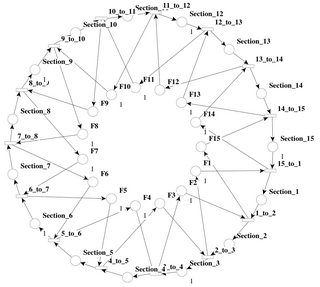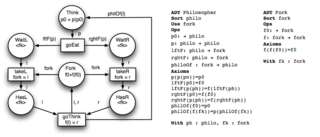Related Research Articles

A Petri net, also known as a place/transition (PT) net, is one of several mathematical modeling languages for the description of distributed systems. It is a class of discrete event dynamic system. A Petri net is a directed bipartite graph that has two types of elements, places and transitions. Place elements are depicted as white circles and transition elements are depicted as rectangles. A place can contain any number of tokens, depicted as black circles. A transition is enabled if all places connected to it as inputs contain at least one token. Some sources state that Petri nets were invented in August 1939 by Carl Adam Petri—at the age of 13—for the purpose of describing chemical processes.

Carl Adam Petri was a German mathematician and computer scientist.
In computer science, concurrency semantics is a way to give meaning to concurrent systems in a mathematically rigorous way. Concurrency semantics is often based on mathematical theories of concurrency such as various process calculi, the actor model, or Petri nets.
Coloured Petri nets are a backward compatible extension of the mathematical concept of Petri nets.

PetriScript is a modeling language for Petri nets, designed by Alexandre Hamez and Xavier Renault. The CPN-AMI platform provides many tools to work on Petri nets, such as verifying and model-checking tools.
CPN Tools is a tool for editing, simulating, and analyzing high-level Petri nets. It supports basic Petri nets plus timed Petri nets and colored Petri nets. It has a simulator and a state space analysis tool is included.
Well-formed Petri nets are a Petri net class jointly elaborated between the University of Paris 6 and the University of Torino in the early 1990s.
Enterprise engineering is the body of knowledge, principles, and practices used to design all or part of an enterprise. An enterprise is a complex socio-technical system that comprises people, information, and technology that interact with each other and their environment in support of a common mission. One definition is: "an enterprise life-cycle oriented discipline for the identification, design, and implementation of enterprises and their continuous evolution", supported by enterprise modelling. The discipline examines each aspect of the enterprise, including business processes, information flows, material flows, and organizational structure. Enterprise engineering may focus on the design of the enterprise as a whole, or on the design and integration of certain business components.

Willibrordus Martinus Pancratius van der Aalst is a Dutch computer scientist and full professor at RWTH Aachen University, leading the Process and Data Science (PADS) group. His research and teaching interests include information systems, workflow management, Petri nets, process mining, specification languages, and simulation. He is also known for his work on workflow patterns.

An algebraic Petri net (APN) is an evolution of the well known Petri net in which elements of user defined data types replace black tokens. This formalism can be compared to coloured Petri nets (CPN) in many aspects. However, in the APN case, the semantics of the data types is given by an axiomatization enabling proofs and computations on it.
The Theory of regions is an approach for synthesizing a Petri net from a transition system. As such, it aims at recovering concurrent, independent behavior from transitions between global states. Theory of regions handles elementary net systems as well as P/T nets and other kinds of nets. An important point is that the approach is aimed at the synthesis of unlabeled Petri nets only.
Roméo is an integrated tool environment for modeling, validation and verification of real-time systems modeled as time Petri Nets or stopwatch Petri Nets, extended with parameters.

TAPAAL is a tool for modelling, simulation and verification of Timed-Arc Petri nets developed at Department of Computer Science at Aalborg University in Denmark and it is available for Linux, Windows and Mac OS X platforms.
Stochastic Petri nets are a form of Petri net where the transitions fire after a probabilistic delay determined by a random variable.
Department of Computer Science at Aarhus University is with its 1000 students the largest Computer Science Department in Denmark. Earlier, the department abbreviation was 'DAIMI’, but after a restructure and internationalization, the abbreviation of the department became CS AU, short for Department of Computer Science, Aarhus University.
Rüdiger Valk is a German mathematician. From 1976 to 2010 he was Professor for Theoretical Computer Science (Informatics) at the Institut für Informatik of the University of Hamburg, Germany.
Nets within Nets is a modelling method belonging to the family of Petri nets. This method is distinguished from other sorts of Petri nets by the possibility to provide their tokens with a proper structure, which is based on Petri net modelling again. Hence, a net can contain further net items, being able to move around and fire themselves.
Petri net (PN) slicing is a syntactic technique used to reduce a PN model based on a given criterion. Informally, a slicing criterion could be a property for which a PN model is analyzed or is a set of places, transitions, or both. A sliced part constitutes only that part of a PN model that may affect the criteria.
Petri Nets, the International Conference on Applications and Theory of Petri Nets and Concurrency is an academic conference organized annually by the Petri net community. The conference was first organized in 1980 Strasbourg, France Since then the conference has been organized annually. The Petri Nets Steering Committee is responsible for the conference, including selection of organisers, PC members, invited speakers, tutorials and workshops, etc.
Signal Transition Graphs (STGs) are typically used in electronic engineering and computer engineering to describe dynamic behaviour of asynchronous circuits, for the purposes of their analysis or synthesis.
References
- ↑ "Kurt Jensen". Google Scholar . Retrieved May 8, 2014.
- ↑ Kurt Jensen (1987). "Coloured Petri nets". Petri Nets: Central Models and Their Properties. Lecture Notes in Computer Science. Vol. 254. pp. 248–299. doi:10.1007/bfb0046842. ISBN 978-3-540-17905-4.